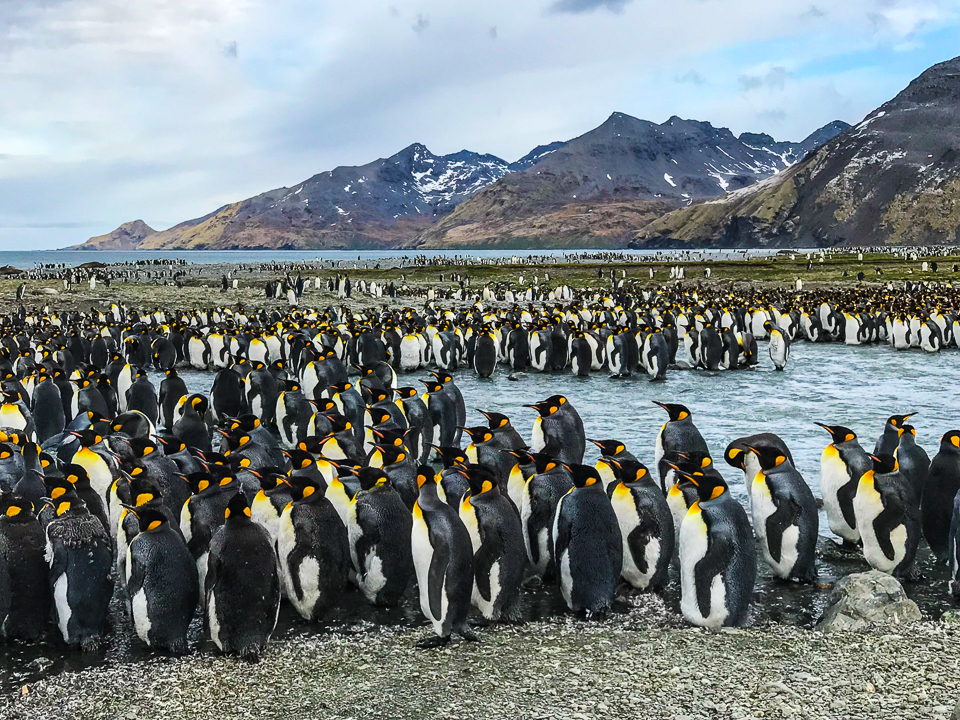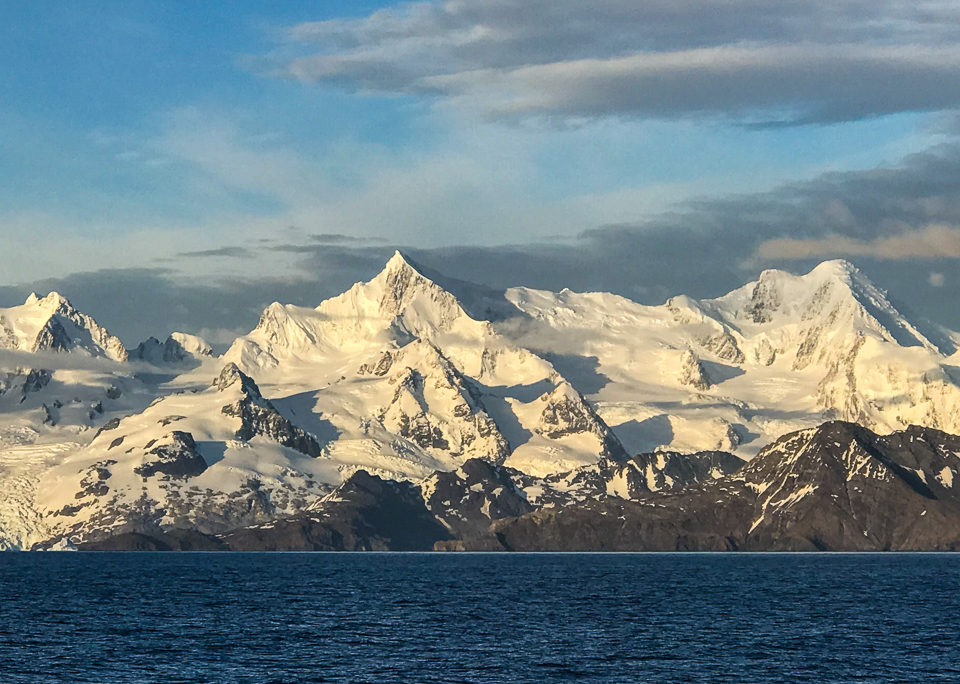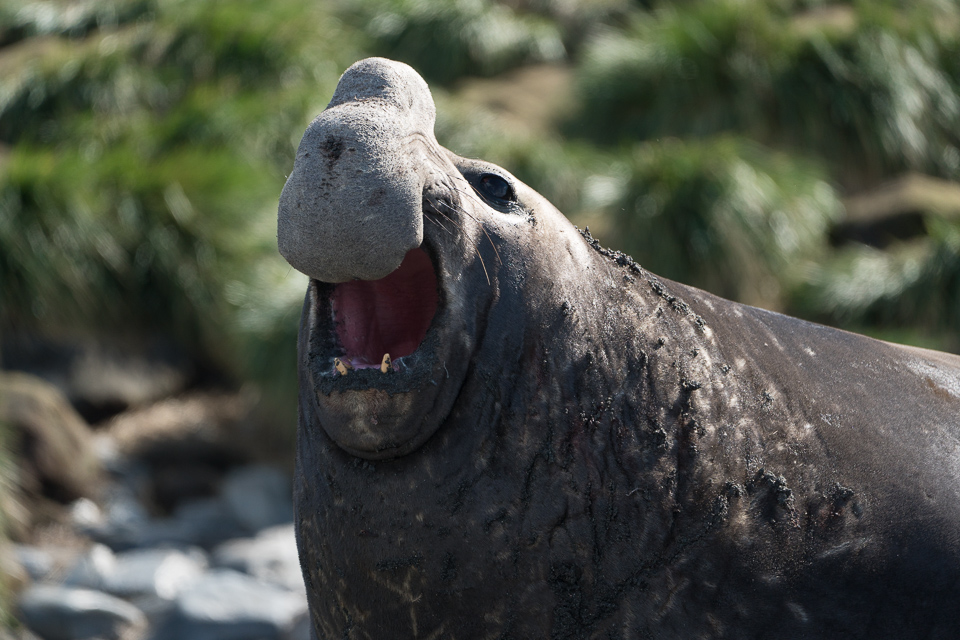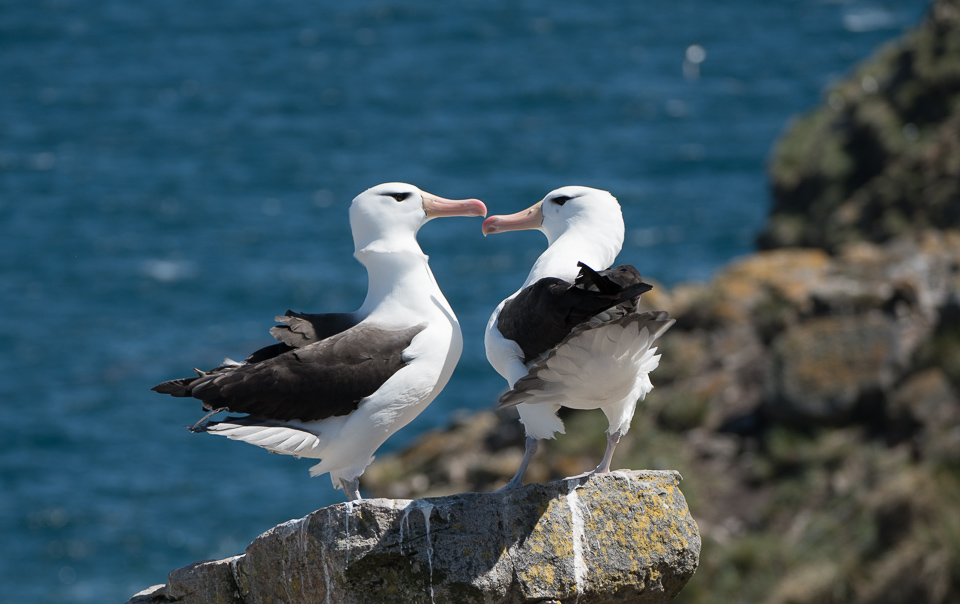
October 21 – November 7, 2017
“The stark polar lands grip the hearts of men who have lived on them in a manner hardly understood by people who’ve never got beyond the pale of civilization.”
—Explorer Sir Ernest Shackleton
After two days at sea from Puerto Madryn, Argentina, we make a morning landing to observe birds near a small settlement on Carcass Island in the Falklands. The number of species in the Falklands (over 200) is impressive. These islands, we’re told, have more striated caracaras, slender-beaked prions and pale-mantled sooty albatrosses than anywhere else in the world..
Two more days at sea, filled with daytime lectures and evening documentaries about upcoming destinations, bring us to remote Shag Rocks, their lonely pinnacles rising above the turbulent, white-capped waves of the Southern Ocean. We’re still some 150 miles from South Georgia.

Early the next morning, South Georgia’s rugged, snow-covered peaks loom on our starboard side. The weather is sunny; the temperature 32 degrees F. We’ve finally arrived at the destination veteran travelers on our cruise say is their absolute favorite. An Australian man confesses this is his fifth visit. Both an American woman and a Canadian couple were here just 10 months ago. How lucky that our itinerary allows more days on the island than other expeditions. Some 1,400 miles from the tip of South America, South Georgia is uninhabited except for a handful of non-permanent residents at a couple of British research stations and at Grytviken, a former whaling station, now site of a museum managed by the conservation-oriented South Georgia Heritage Trust.
Over the next six days, thanks to good weather and relatively calm seas, we make more landings than any of us expected. All are in bays and coves on the more protected, calmer side of the island. Time and space allow us to mention only a few.
Gold Harbour proves to be one of the island’s most beautiful sites. An amphitheater of hanging glaciers and sheer cliffs provides a dramatic backdrop for an abundance of seabirds and seals. The king penguin colony along the beach and shallow streams here numbers around 25,000 breeding pairs. Hundreds of gentoos and other species of penguins, nest in the surrounding tussock grass. Back on the beach, male elephant seals (bulls) protect their female “harems.” These enormous, bellowing animals—males can weigh over 3 tons—are perhaps Nature’s most wretched and ugliest creatures. We watch two bulls, called “beachmasters,” fight ferociously for dominance over a harem of some 50 females. Beachmasters drive off other males until a stronger one comes along to “dethrone” him. Best not to get near these big guys!

St. Andrews Bay provides one of South Georgia’s highlights. The King Penguin rookery here numbers some 200,000 breeding pairs—one of the largest concentrations of wildlife on the planet. As far as the eye can see, penguins crowd together on a vast glacial delta against a backdrop of snow-powdered peaks— a scene that’s unbelievable until you’ve seen it. Here and there, large groups of penguins bathe and frolic in the surf. Others congregate on the beach to watch us climb out of the Zodiacs. Meanwhile, elephant and fur seals are chilling out near the penguins. We’re advised to steer clear of the fur seals since they’re “born angry” and can be aggressive. It’s Animal Planet on steroids. And we have plenty of time ashore to take in the spectacle. How exhilarating to be this close to nature in the raw!
We visit Grytviken. an “industrial archaeology” site, for a full day. The remains of one of the largest, former whaling stations on South Georgia, founded in 1904, includes whaling ships stranded along the beach, remains of whale processing facilities and the accommodations for the up to 300 mostly Norwegian whalers who once lived here in the first half of the 20th century. Their work separated them from their families for long periods and was arduous. But it paid well. Whaling operations lasted, in fact, until the 1960s when the demand for whale oil had all but disappeared. A small museum showcases memorabilia and artifacts from whaling days. Up a small hill, we visit the grave of legendary explorer Sir Ernest Shackleton, then, at the museum, see a replica of the James Caird—the small, open boat in which Shackleton and his comrades miraculously survived a voyage of some 800 miles at sea.
For details on cruises, visit poseidonexpeditions.com. For more about our own experiences aboard the Sea Spirit, check out this story, other blog posts (enter “poseidon” in the search box above ) and this short film.

Our return to Ushuaia, Argentina, includes two more landings in the Falklands. We explore Stanley, the capital, and successfully shop for a hand-knitted sweater made of the exceptionally soft wool for which the Falklands are famous. For our grand finale, we cruise overnight to West Point Island to visit a large colony of black-browed albatrosses (some 4,000 breeding pairs, we’re told) on the side of steep hill overlooking the sea.
How exciting to be up close and personal with these majestic birds! How close, you ask? Close enough to take a photo of nesting birds with an iPhone. Close enough to feel and hear the swoosh of their powerful wings (a black-browed albatross’s wing span is around 8 feet) as they circle by, only a foot or two away. On their nests, some are performing elaborate courtship dances; others are incubating eggs. We try repeatedly to photograph them both in flight and on their nests—an effort that becomes addictive. Finally, after three hours with the albatrosses, we hike to the home of a fifth-generation Falkland Island couple for tea and cookies before returning by Zodiac to the Sea Spirit.
We find Poseidon’s expedition team to be extremely efficient and safety conscious every time they transport us between ship and shore . And they do it with genuine enthusiasm. We’ve made many more landings than anyone expected— altogether remarkable. For more details and images, check for our illustrated feature story and documentary film to follow soon.
For details on cruises, visit poseidonexpeditions.com. For more about our own experiences aboard the Sea Spirit, check out this story, our other blog posts (enter “Poseidon” in the search box above ) and this short film.
